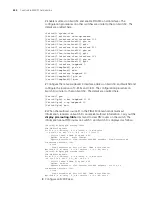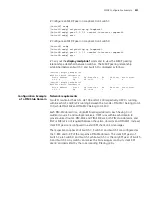
486
C
HAPTER
48: MSDP C
ONFIGURATION
As shown in Figure 123, within a PIM-SM domain, a multicast source sends
multicast data to multicast group G, and Receiver is a member of the multicast
group. To implement Anycast RP, configure the same IP address (known as anycast
RP address, typically a private address) on Router A and Router B, configure these
interfaces as C-RPs, and establish an MSDP peering relationship between Router A
and Router B.
n
Usually an Anycast RP address is configured on a logic interface, like a loopback
interface.
Figure 123
Typical network diagram of Anycast RP
The work process of Anycast RP is as follows:
1
The multicast source registers with the nearest RP. In this example, Source registers
with RP 1, with its multicast data encapsulated in the register message. When the
register message arrives at RP 1, RP 1 decapsulates the message.
2
Receivers send join messages to the nearest RP to join the RPT rooted as this RP. In
this example, Receiver joins the RPT rooted at RP 2.
3
RPs share the registered multicast information by means of SA messages. In this
example, RP 1 creates an SA message and sends it to RP 2, with the multicast data
from Source encapsulated in the SA message. When the SA message reaches RP 2,
RP 2 decapsulates the message.
4
Receivers receive the multicast data along the RPT and directly join the SPT rooted
at the multicast source. In this example, RP 2 forwards the multicast data down
the RPT. When Receiver receives the multicast data from Source, it directly joins
the SPT rooted at Source.
The significance of Anycast RP is as follows:
■
Optimal RP path: A multicast source registers with the nearest RP so that an
SPT with the optimal path is built; a receiver joins the nearest RP so that an RPT
with the optimal path is built.
■
Load balancing between RPs: Each RP just needs to maintain part of the
source/group information within the PIM-SM domain and forward part of the
multicast data, thus achieving load balancing between different RPs.
SA message
Source
Receiver
Router A
Router B
RP 1
RP 2
PIM-SM
MSDP peers
Summary of Contents for Switch 7757
Page 32: ...32 CHAPTER 1 CLI OVERVIEW...
Page 70: ...70 CHAPTER 5 LOGGING IN USING MODEM...
Page 76: ...76 CHAPTER 7 LOGGING IN THROUGH NMS...
Page 86: ...86 CHAPTER 9 CONFIGURATION FILE MANAGEMENT...
Page 120: ...120 CHAPTER 13 ISOLATE USER VLAN CONFIGURATION...
Page 126: ...126 CHAPTER 14 SUPER VLAN...
Page 136: ...136 CHAPTER 16 IP PERFORMANCE CONFIGURATION...
Page 152: ...152 CHAPTER 17 IPX CONFIGURATION...
Page 164: ...164 CHAPTER 19 QINQ CONFIGURATION...
Page 172: ...172 CHAPTER 21 SHARED VLAN CONFIGURATION...
Page 182: ...182 CHAPTER 22 PORT BASIC CONFIGURATION...
Page 198: ...198 CHAPTER 24 PORT ISOLATION CONFIGURATION...
Page 208: ...208 CHAPTER 25 PORT SECURITY CONFIGURATION...
Page 224: ...224 CHAPTER 27 DLDP CONFIGURATION...
Page 232: ...232 CHAPTER 28 MAC ADDRESS TABLE MANAGEMENT...
Page 240: ...240 CHAPTER 29 CENTRALIZED MAC ADDRESS AUTHENTICATION CONFIGURATION...
Page 280: ...280 CHAPTER 30 MSTP CONFIGURATION...
Page 348: ...348 CHAPTER 35 IS IS CONFIGURATION...
Page 408: ...408 CHAPTER 39 802 1X CONFIGURATION...
Page 412: ...412 CHAPTER 40 HABP CONFIGURATION...
Page 422: ...422 CHAPTER 41 MULTICAST OVERVIEW...
Page 426: ...426 CHAPTER 42 GMRP CONFIGURATION...
Page 480: ...480 CHAPTER 47 PIM CONFIGURATION...
Page 506: ...506 CHAPTER 48 MSDP CONFIGURATION...
Page 552: ...552 CHAPTER 51 TRAFFIC ACCOUNTING CONFIGURATION...
Page 570: ...570 CHAPTER 53 HA CONFIGURATION...
Page 582: ...582 CHAPTER 54 ARP CONFIGURATION SwitchA arp protective down recover interval 200...
Page 622: ...622 CHAPTER 58 DHCP RELAY AGENT CONFIGURATION...
Page 684: ...684 CHAPTER 61 QOS CONFIGURATION...
Page 718: ...718 CHAPTER 63 CLUSTER...
Page 738: ...738 CHAPTER 67 UDP HELPER CONFIGURATION...
Page 752: ...752 CHAPTER 69 RMON CONFIGURATION...
Page 772: ...772 CHAPTER 70 NTP CONFIGURATION...
Page 796: ...796 CHAPTER 72 FILE SYSTEM MANAGEMENT...
Page 802: ...802 CHAPTER 73 BIMS CONFIGURATION...
Page 814: ...814 CHAPTER 74 FTP AND TFTP CONFIGURATION...
Page 830: ...830 CHAPTER 75 INFORMATION CENTER...
Page 836: ...836 CHAPTER 76 DNS CONFIGURATION...
Page 852: ...852 CHAPTER 77 BOOTROM AND HOST SOFTWARE LOADING...
Page 858: ...858 CHAPTER 78 BASIC SYSTEM CONFIGURATION DEBUGGING...
















































